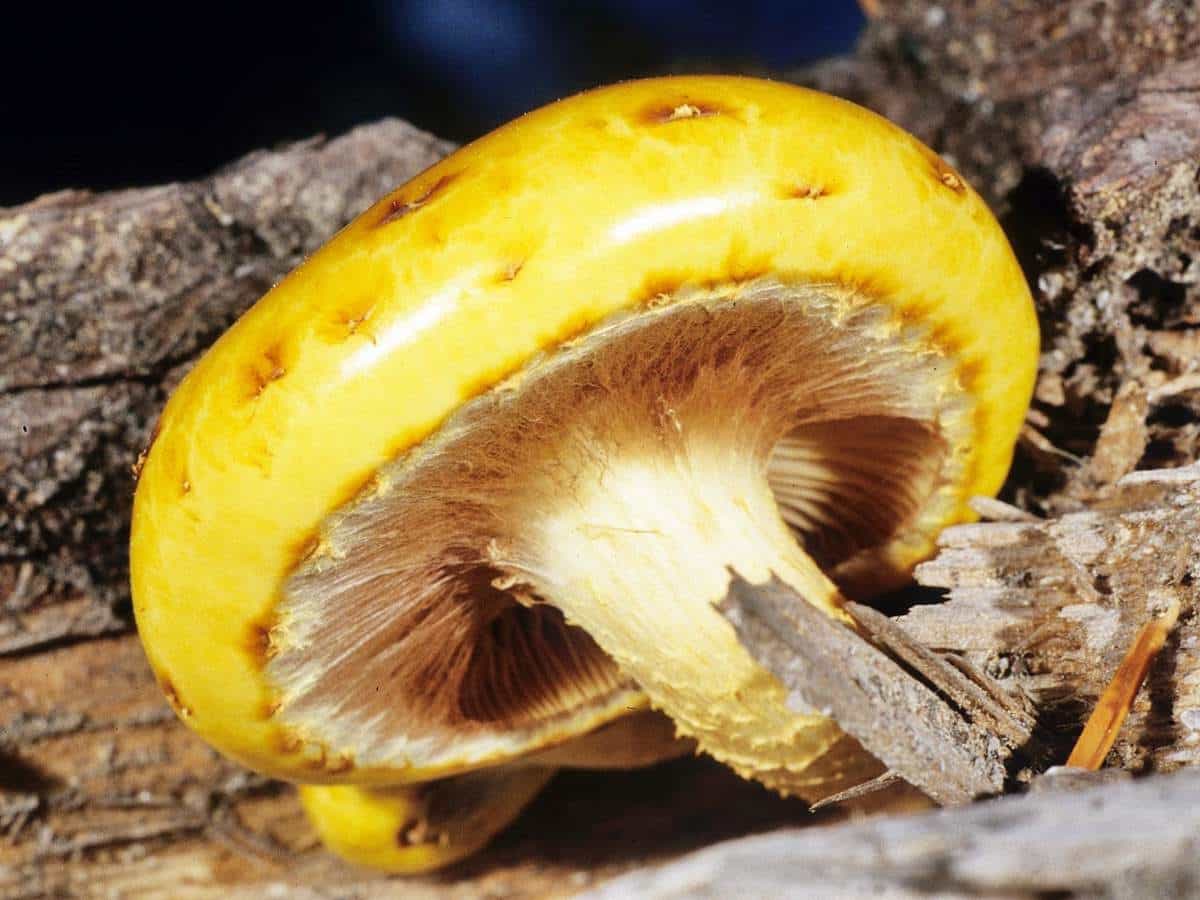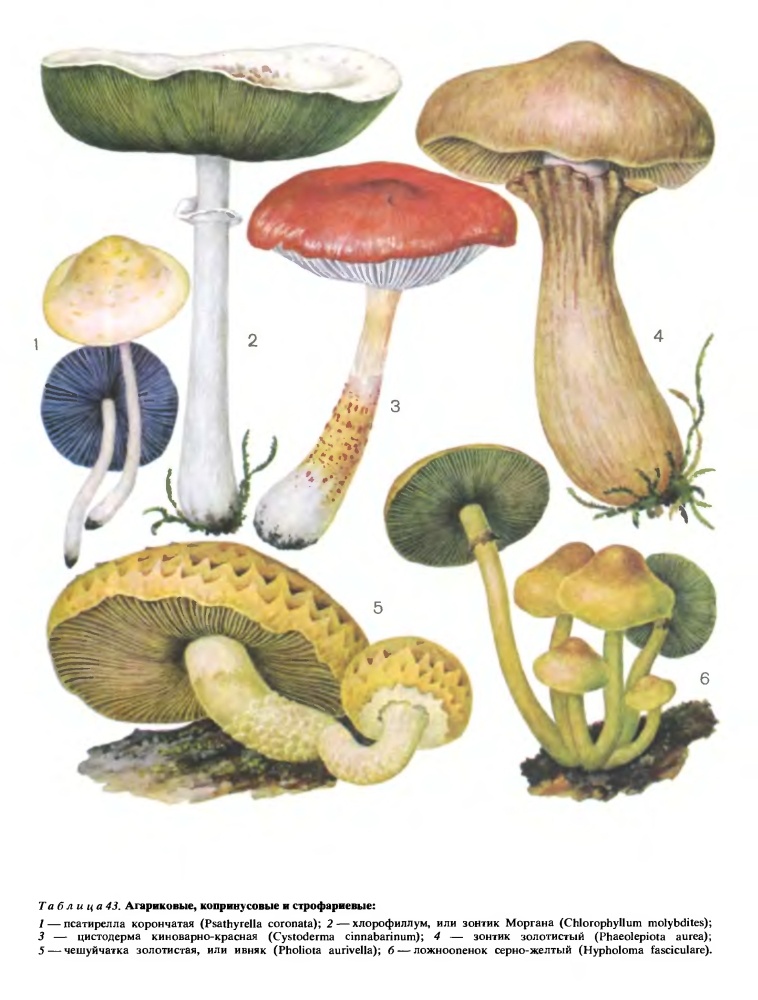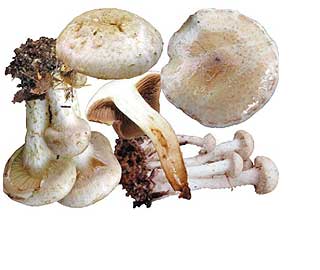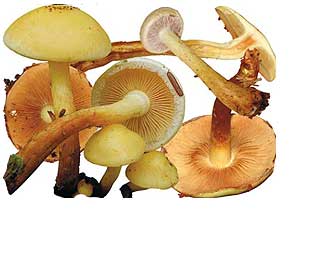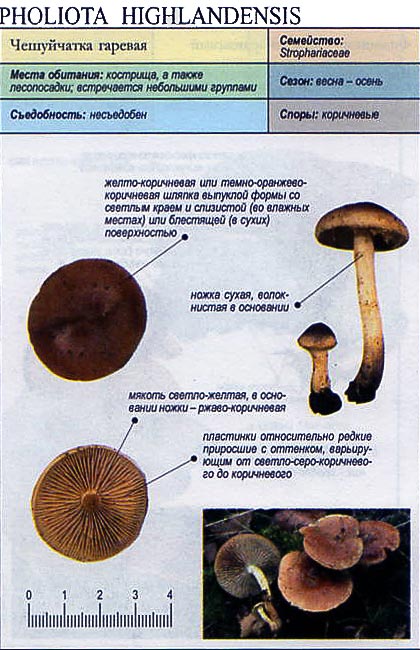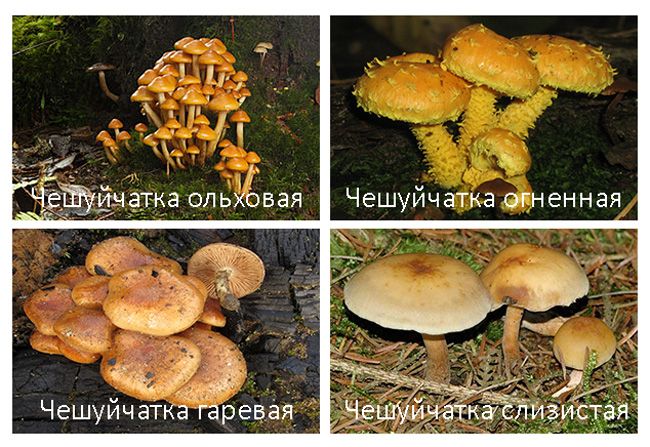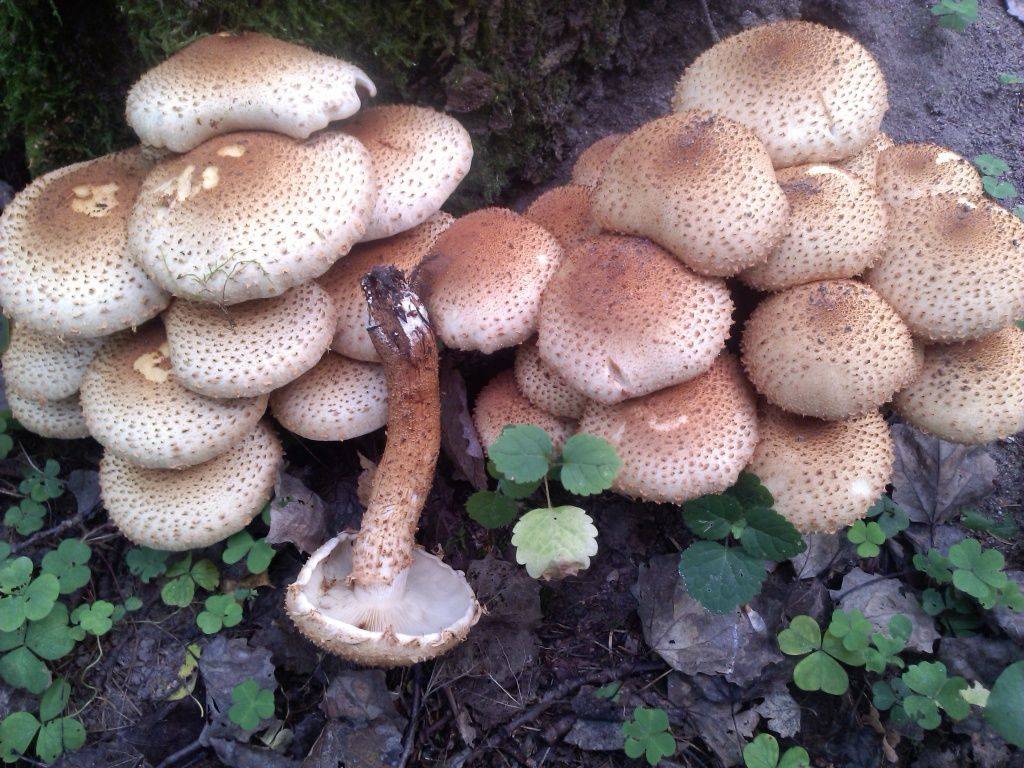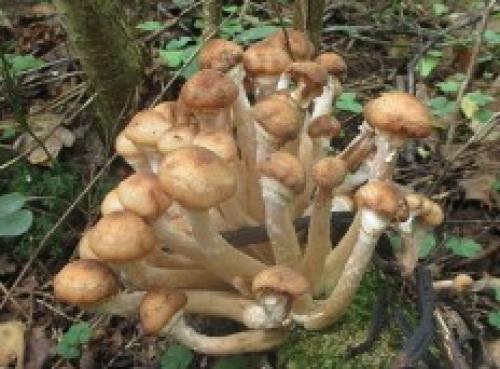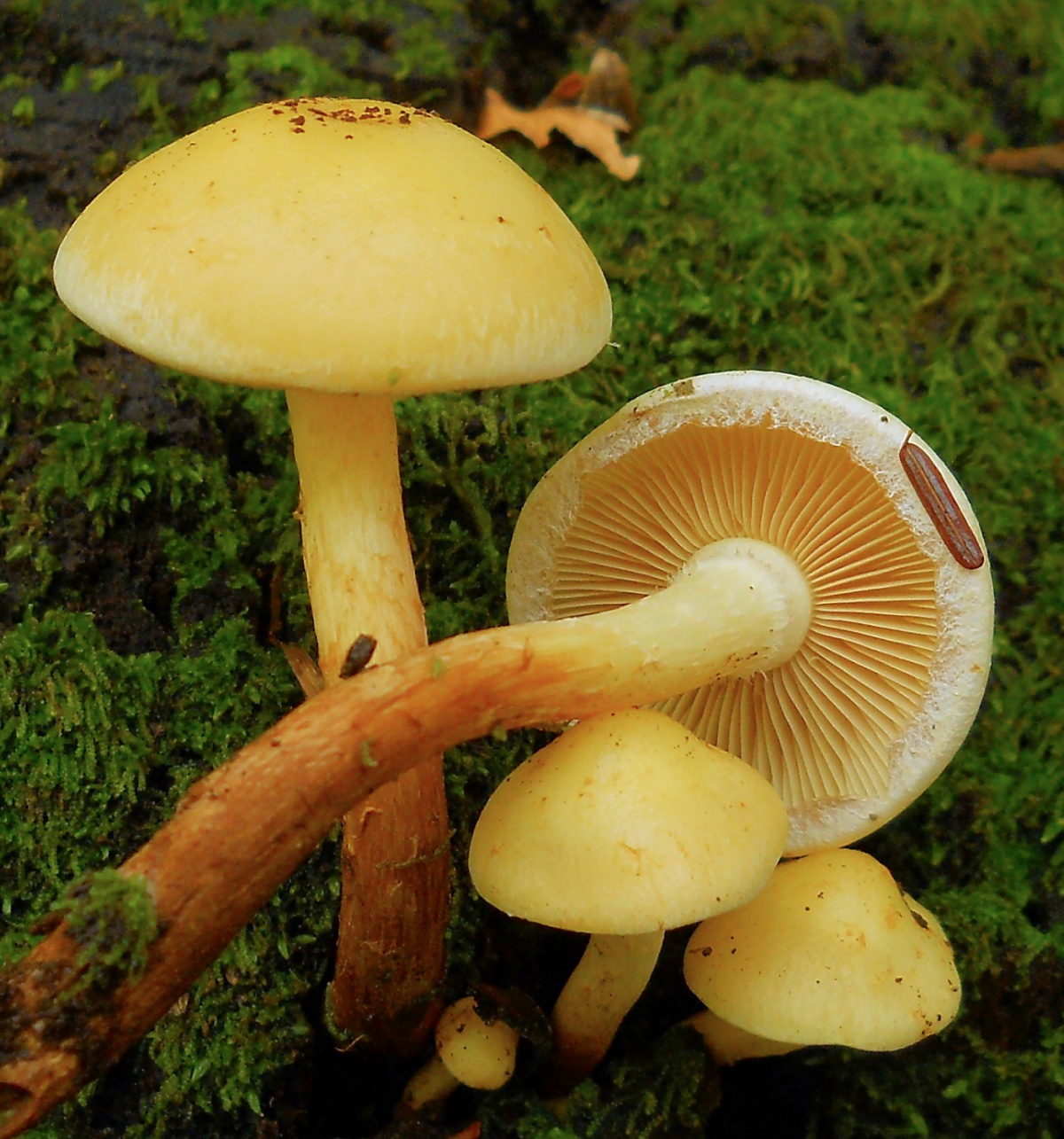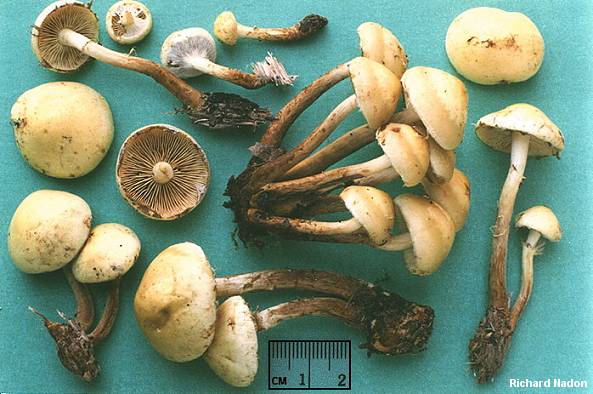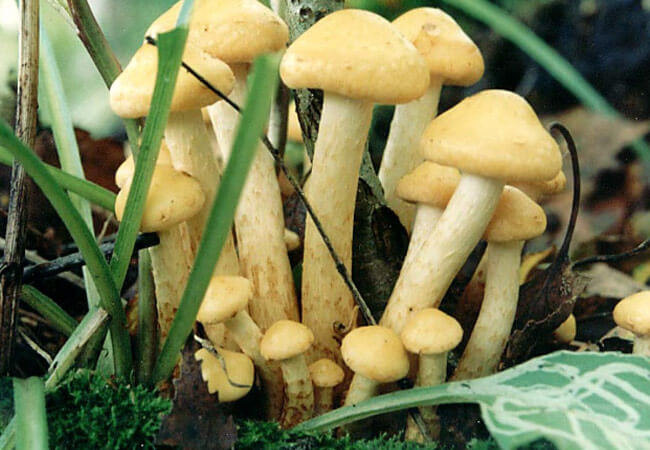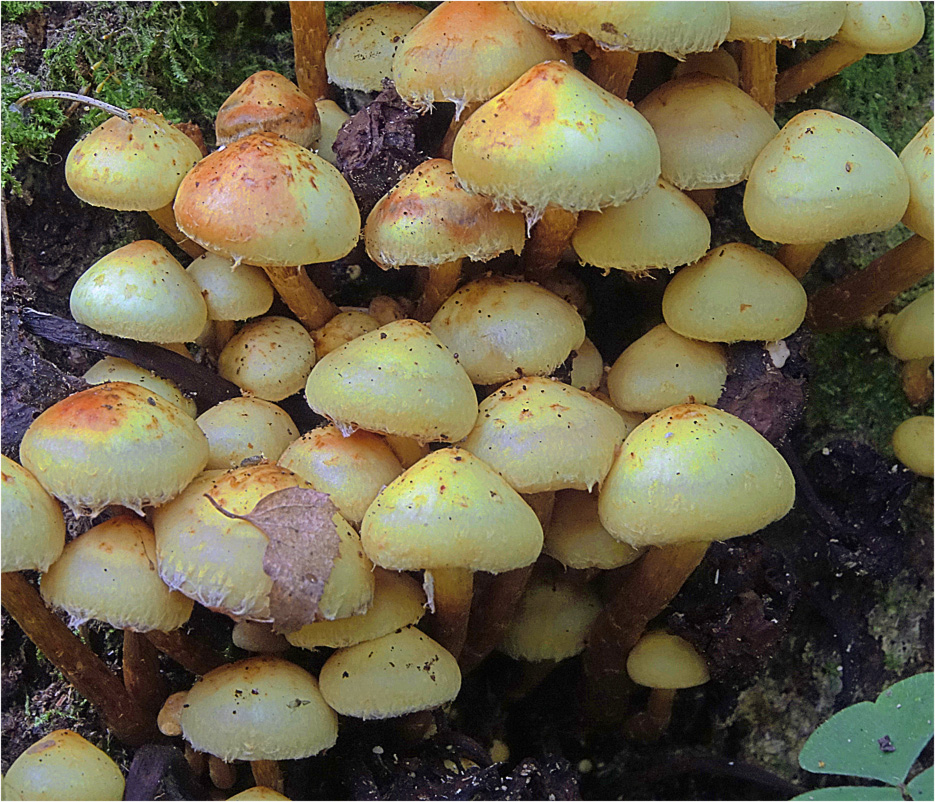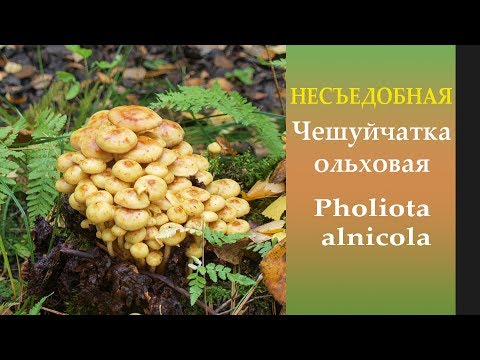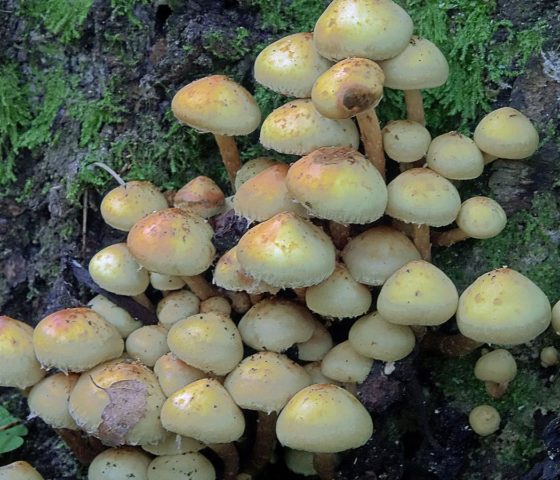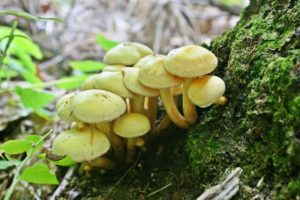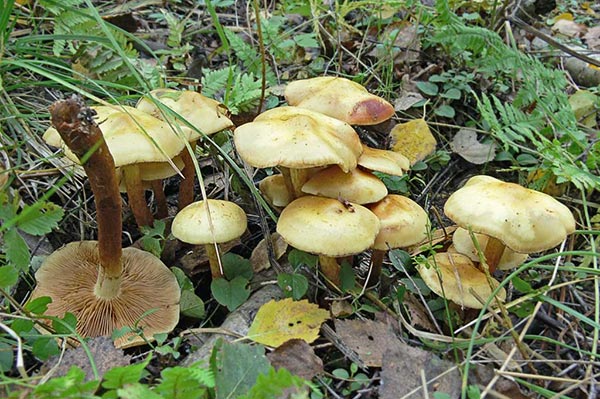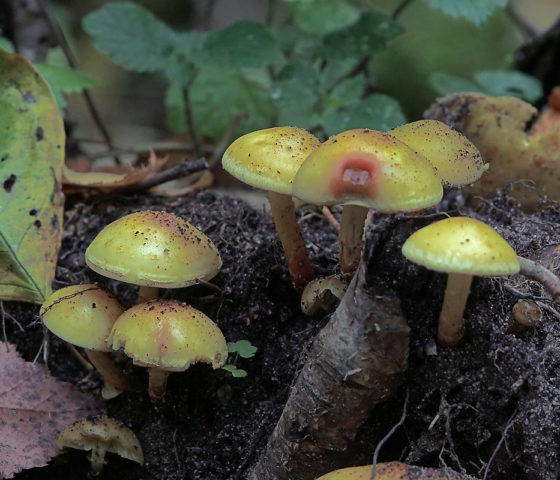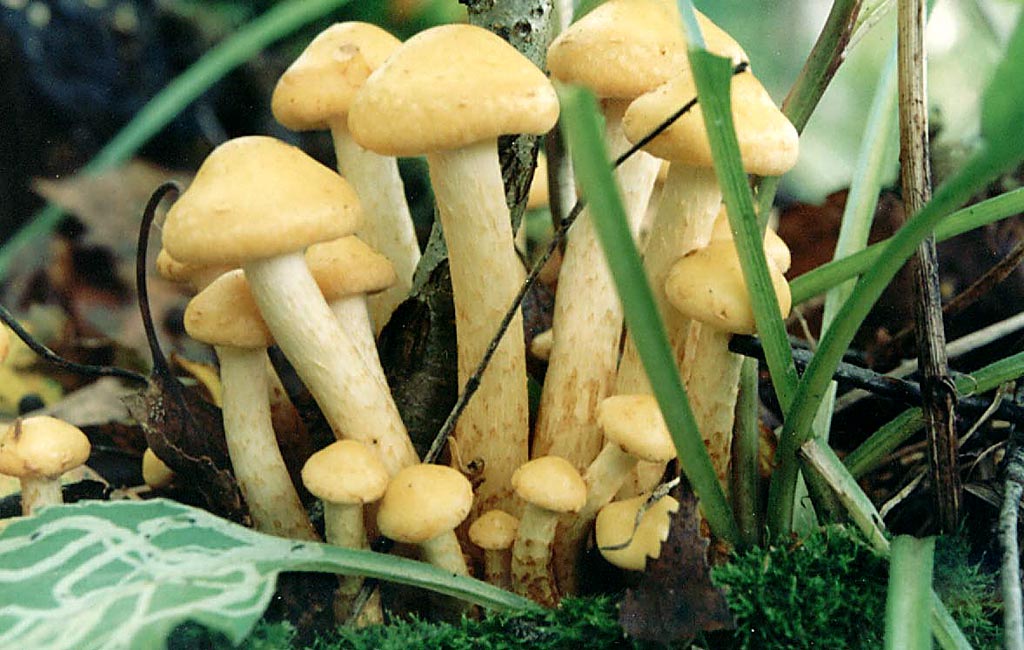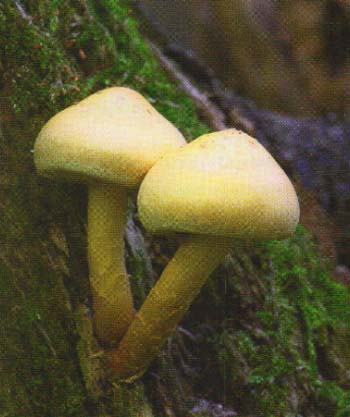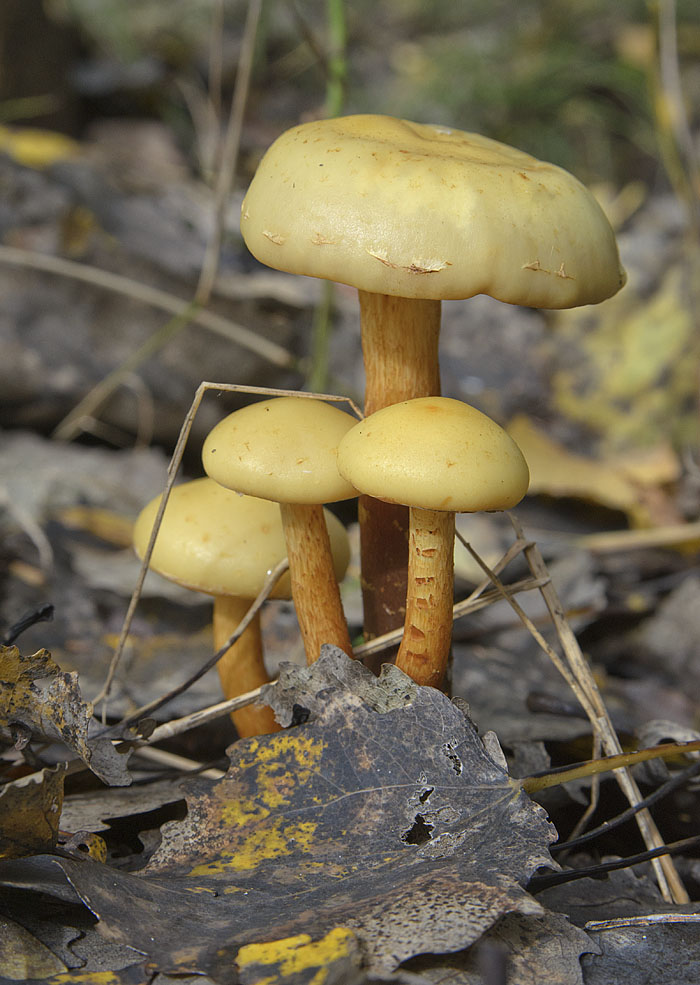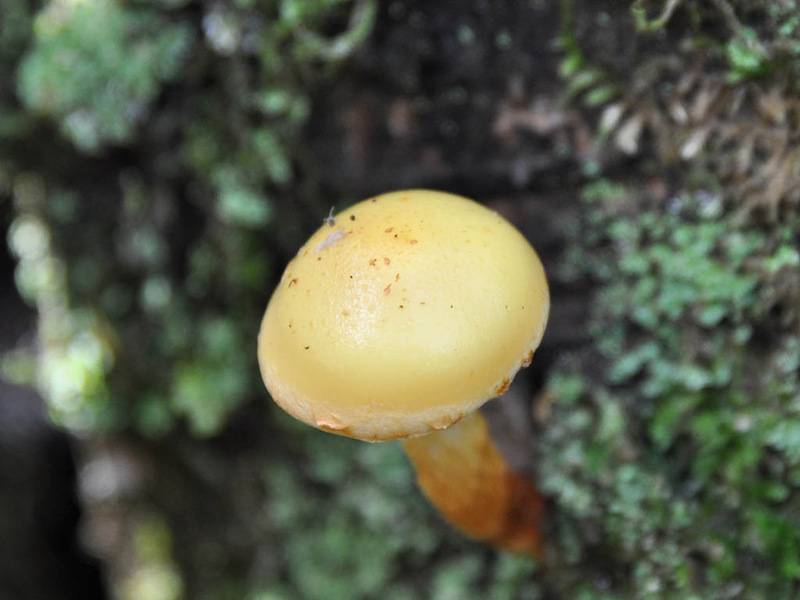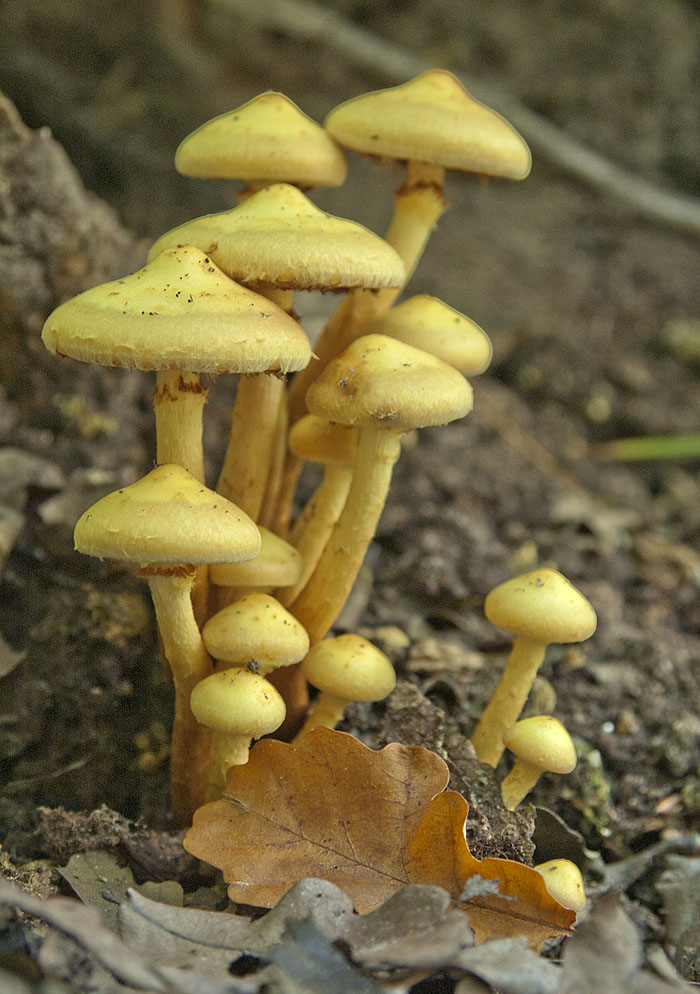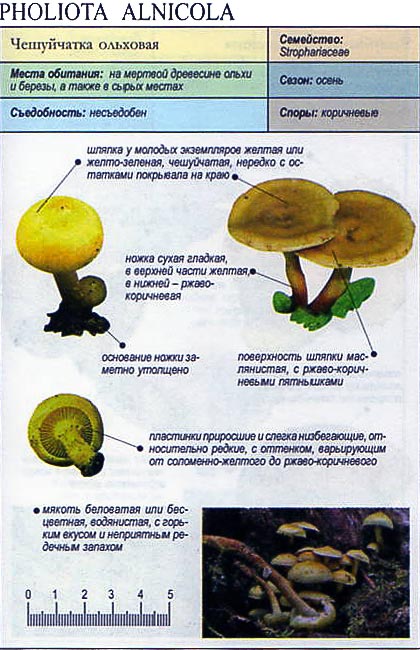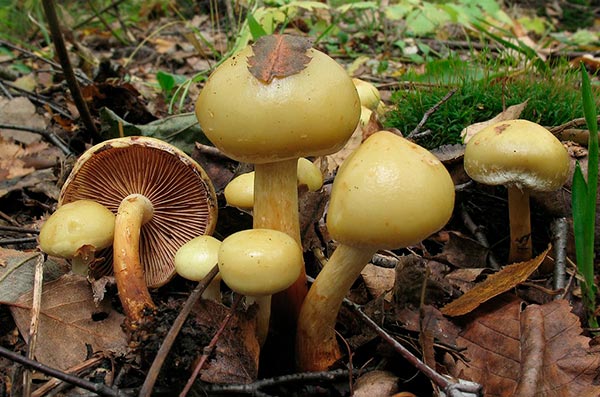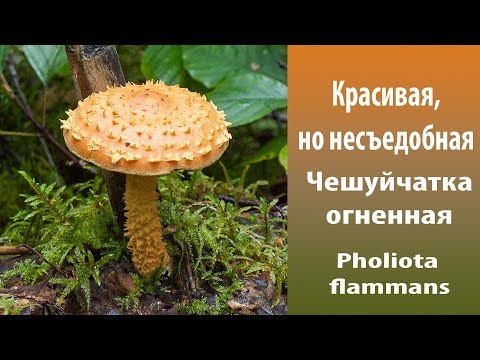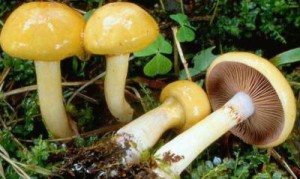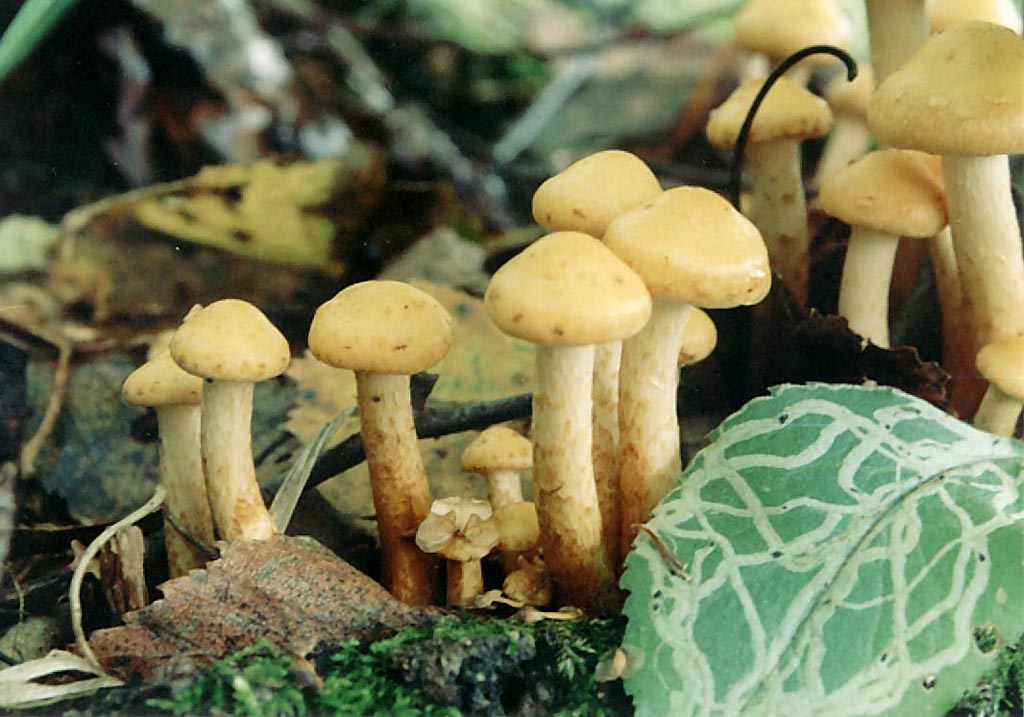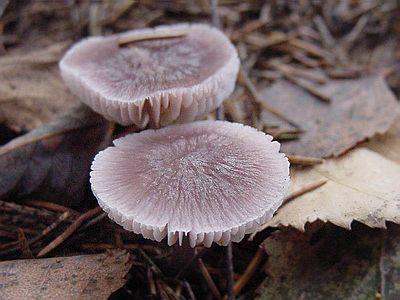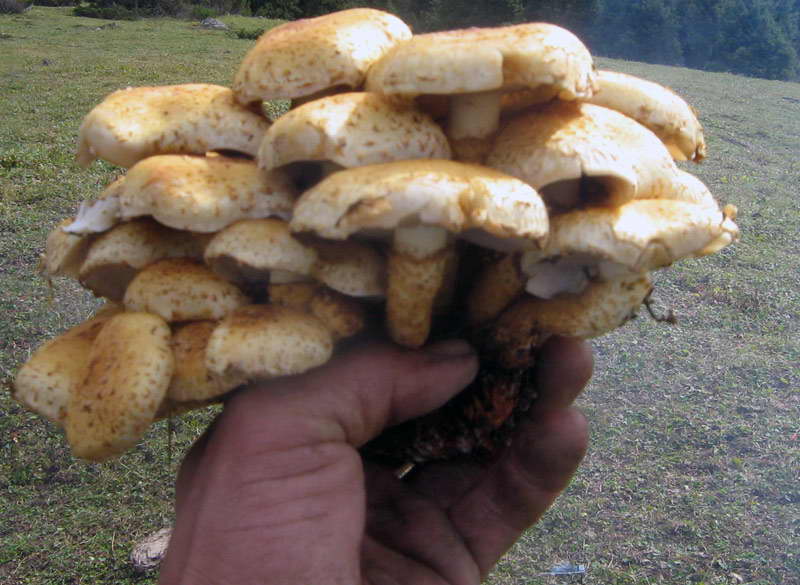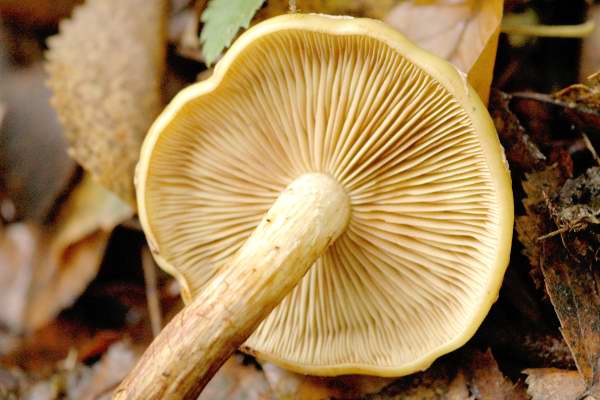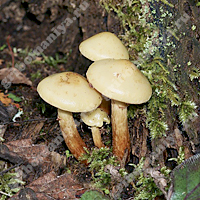Alder scales, Pholiota alnicola
Hat: In youth, hemispherical, then simply convex, over time it becomes almost prostrate. Diameter 4-6 cm. The color is yellow-lemon, with rare scales of almost the same color (therefore they are not visible), the surface is sticky, shiny. The pulp is yellowish, without a special smell, the taste is bitter.
Hymenophore: The plates are frequent, adherent, lemon-yellow in youth, darken as the spores mature. In youth, they are covered with a white, web-like private veil, which, as a rule, does not leave a noticeable ring.
Spore powder: Brown.
Leg: Height 5-10 cm, thickness 0.5 - 1 cm, cylindrical, dense, in the upper part - the same color as the cap or even lighter, darker at the bottom due to numerous scales.
Spreading: Pholiota alnicola occurs in August-September on the remains of deciduous trees (especially alder and birch), as well as on the soil around them. Can form large colonies.
Similar species: Immediately you should sweep aside the sulfur-yellow honey fungus (Hypholoma fasciculare), which is similar to this scaly only in terms of growth. There are much more differences, including the dominant sulphurous hue and darker plates. In general, it is not difficult to distinguish this scale from other representatives of the genus Pholiota: the pine scale (Pholiota spumosa) grows on pine stumps, and the cap of the fire scale (Pholiota flammans) is completely covered with large scales.
Addendum: According to Kurtekis, there are a number of very similar types of yellow scales:
1. Pholiota alnicola is the ancestor of the “alder” series. It has a strong aromatic odor and a pronounced cortina, which turns brown from the base. Cortina is clearly visible on a yellow leg. The largest in the group. Prefers alder. 2. Pholiota salicicola is a small “willow” version of alnikola that has no odor. 3. Pholiota flavida - a lighter version, odorless, growing on conifers. 4. Pholiota apicrea is a more powerful and pale-colored version with a strong cinnamon scent at the base of the stem. 5. Pholiota pinicola is already a separate species, with a more brownish-red hue, with a slightly pronounced corticum and with a faint odor. Prefers pine.
Edibility: Pholiota alnicola is said to be considered an inedible mushroom due to its bitter taste - like most flakes, in fact. And, together with the majority, it is considered completely unfounded.
Author's notes: In July, I found the first one, on a linden tree: it peeped out of a crack in the bark at the height of my height and looked like a flashlight. I liked it right away, although, to be honest, I didn't understand her well. And in August - we climbed. One week (towards the end of the month) it was difficult to find a place in the forest from which not a single colony of this wonderful mushroom could be seen. The forest was dotted with the brightest lemon-yellow spots. Not so often, by the way, mushrooms show us such pure colors.
But to be honest, I had no idea how to taste alder flakes. Somehow it goes without saying that this mushroom is inedible. As well as many things that are so pleasant to eat with your eyes.
Year after year is not necessary: in the hot summer of 2005, alder scales looked timid and even somehow plaintive. However, almost all the other mushrooms did not look at all at all - there were none, there were none at all.
The mushroom is so photogenic that it was impossible to stop filming. It is a pity that we will not see the most important thing: namely, a huge oak stump, all covered with young bunches of alder scales. The tape ran out.
Alder flakes are one of the most lemon mushrooms I've ever seen. Lemon hat, lemon stem, lemon plates. only the private bedspread seems to be white. White and spiderweb. Looking at this picture, it becomes more or less clear why scales used to be counted among cobwebs.
Time spares no one, especially mushrooms. And even the bright, airy alder scales, charging the inhabitants and guests of the forest with irrepressible optimism, at the end of their life's journey becomes dull and lethargic.
Not to say that we have before us old, withered specimens, formed in unnatural conditions. This flake strives to save face at any cost, and most often it still succeeds.
It seems that such an attractive mushroom must be edible and tasty. Oh, they would have procured it - the autumn forest would have had to rest nervously! Maybe this is the reason why alder flakes have no practical value. Reasonable of her.
Types of scales
The genus of flakes has about 150 species, of which about 30 grow in the forests of Russia. The most common types are foliots: ordinary, golden, fiery, cinder, alder, gum-bearing, destructive, edible (hint).
Common scaly
This is the most common type. Mushrooms of this type are also called fleecy, scaly, dry. They grow in colonies on the wood of living and rotten deciduous trees. The hats have a diameter of 6-10 cm, in young ones they are hemispherical, in mature ones they are flat. The surface of the caps is pale yellow with pronounced orange-brown scales.
The leg is cylindrical, dense, rusty. Young specimens have a private veil that breaks when ripe, forming a ring on their stem and flakes around the edges of the cap.
The flesh of this species is fleshy, white or yellow, although edible, but tastes bitter.
Scale golden (royal honey mushrooms)
The golden species is one of the largest representatives of the foliot: the diameter of the cap can reach 18 cm. Their fruit bodies are colored bright yellow, golden. The surface of the cap is covered with mucus and small dark brown scales. In young specimens, the cap has a hemispherical shape with tucked edges; in adulthood, it is a saucer shape with a convex center.
Flame scale
This is an inedible type of foliot. Mushrooms of this species are smaller than ordinary or golden ones: the diameter of the caps does not exceed 7 cm. The caps are painted in reddish tones and are covered with thick curled scales of a lighter color than the cap. The scales on the cap form a pattern of ovals. The pulp is fleshy, hard, yellow in color, when broken, it becomes brown, has an astringent bitter taste and an unpleasant odor, therefore it is not eaten. Fruiting from mid-July to late September.
Cinder flakes
Cinder flakes are also called coal-loving ones. The caps of this type of mushroom are often stained with soot and dirt, since burnt trees and fireplaces are their favorite places of growth. Soot, dust and dirt adhere to the mucous surface of the caps, so the mushrooms quickly turn dirty yellow or dirty brown. In young foliots, the caps are covered with a private veil; in mature foliots, the remains of this veil are preserved in the form of a ring on the leg and along the edges of the cap. The legs are covered with small reddish scales. The pulp of these foliots is dense, tough, light yellow, and has no specific taste or smell. There is no information on the edibility of these mushrooms in the literature. They grow from August to October.
Alder flakes
These foliots are also called the alder moth. They are often found on stumps and wood of alder or birch. The size of the caps of the moth is small: it does not exceed 5-6 cm. The color of the caps is yellow-orange, along their edge there are flaky remnants of a private bedspread. The legs are curved, have a pronounced ring. Below the rings are fibrous, above the rings are smooth.
The pulp of the mushrooms is yellowish, dirty yellow, inedible. When eaten, moths can cause poisoning. Fruiting in August-September.
Scaly gummy
These mushrooms are also called yellow-green because their fruiting bodies, covered with scales, are light yellow to yellow-green in color. The diameter of the caps of gum-bearing foliots is 3-6 cm. The pulp is edible, since it does not have a rare taste and odor specific to scales.
Destructive scales
These mushrooms are often found on old and dry poplars, therefore their second name is poplar or poplar foliot. These mushrooms, in the process of their growth, actively destroy the wood of the tree. Caps can reach 20 cm, are light brown or yellowish, covered with white scales. Legs are thinned towards the top, have bulges at the base. The legs are the same color as the caps and are also covered with scales.
Edible flakes
This type of foliot is industrial. Mushrooms of this species are cultivated on a large scale in Japan and China. Their second name is foliot or hint of honey. Grown in rooms with high humidity - 90-95%. They grow in groups. The sizes of these mushrooms are small - no more than 2 cm in diameter. The color of the fruit bodies is orange-brown, the surface is covered with thick dense jelly-like mucus.
They have soft pulp, similar in taste and smell to real honey mushrooms. On the shelves of our stores, you can often find pickled edible flakes of Chinese production. Only the inscription on the bank says that it is mushrooms (the second name for edible scales). Pickled foliots differ from real honey mushrooms in a slimy marinade, which is due to the jelly-like coating of the caps of the latter.
What a wonderful beast?
In ancient times, people told each other all sorts of fables, and sometimes true stories from life. Then these stories were passed down from generation to generation, overgrown with many different facts. So, there are also rumors and legends about the snake moth. Siberians say that this terrible beast can jump up from the ground more than one and a half meters and bites its prey exclusively in the neck or chest area.
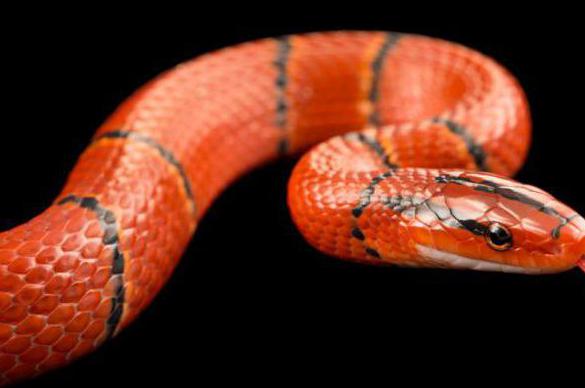
And many more residents of the northern regions of Russia claim that moths can hang on trees to make it easier to attack their prey. Moreover, their prey, in addition to people, can also be cows, on which moth snakes descend from the trees. The bite of such reptiles can be fatal to humans, because, as described above, such a snake stings in the neck or chest. From there, a person is not able to suck the poison on his own, and the situation with a bite does not tolerate delay. By the way, if you take the necessary measures in time (injection or at least suction of the poison), then it is quite possible to avoid negative consequences.
Legend
In Siberia, there is one strange legend among local residents, in which hunters and old-timers firmly believe. It concerns the killing of snakes, namely that if a person is lucky enough to deal with a dangerous reptile, then his sins are forgiven.

We are talking about a fairly large number of sins per hunter, namely 40. Whether this is true or not, everyone decides for himself. But people protect their lives in a cold, harsh land with a special predilection (one hunter or forester can kill about 40 poisonous individuals in a day), as evidenced by the data reported in the media. Such facts are not surprising, because more than 10 million snakes have been registered in Siberia. However, I would like to note that no one has yet provided either a skin or a photo of a moth snake in Siberia.
Snake moth: photo and description of several individuals
The moth got its name for the color it is endowed with. Those who claim to have seen her live speak of three varieties of these reptiles dangerous to humans and livestock:
- The first type of reptile is coal-black with a flattened head and two long teeth in the mouth. Sometimes, however, bright red dots may be present on her head.
- The second type is a moth snake, a photo of which is not so easy to find. She is a red reptile. This is the most dangerous and most venomous snake of all subspecies. Its scales are painted in a red-burgundy color evenly, without transitions and separation in the head and tail, however, on it you can see a kind of braided pattern in the form of equivalent rhombuses.
- Well, and the third description of the moth snake, compiled from the words of eyewitnesses: a black-red reptile, in which the entire body is shaded with red thin stripes.
It is worth saying that the moth is not called a huge snake, it is more like a copperhead or a viper in size. In general, not very big.
Phases of moth development on currants
The beginning of the departure of the butterfly depends on the weather and average daily air temperatures. It usually coincides with the budding phase and the beginning of flowering of early currant varieties.
Five to seven days after emergence, moths lay eggs in flowers. One female can lay up to two hundred eggs. Butterfly years last two to three weeks. Moth eggs are white, oval, about 0.75 mm in size. The main laying of the butterfly is done inside the flowers. In the egg, the future moth develops for about one week. Newborn caterpillars are whitish-yellowish, two to three millimeters long, with a black head.
In one ovary, only one caterpillar feeds, despite how many eggs were laid. "Superfluous" individuals crawl into neighboring ovaries.
The hatched caterpillars begin to devour seeds and berries, enveloping them in cobwebs. Each of them eats up to fifteen currant berries or 5–7 - gooseberries. The color of adult caterpillars is bright green, the head is black. They reach 18 mm in length.
Moth caterpillar
The lifespan of a moth in the form of caterpillars before pupation is different and depends on the weather and the type of plant - "feeder". On the gooseberry, development proceeds faster. On black currants, caterpillar growth is delayed for one and a half weeks and lasts 22-30 days.
Each individual, having completed the next stage of development, descends to the ground along the cobweb, deepens by 5–6 cm and pupates. Pupae of the moth are located in 5–7 pieces in the upper layer or on the surface of the earth under debris, fallen leaves, and clods of soil within a radius of no more than forty centimeters from the bush.
On currants, the moth prefers varieties that bloom profusely during its massive summer. If the spring is early and warm, these are early varieties of Sevchanka, Selechenskaya and others. At low spring temperatures - Lazy, Veloy, that is, late varieties.
✎ affiliation and generic characteristics
Scale (lat.pholiota) or folio is a common genus of mushrooms from the strophariaceous family (lat.strophariaceae), of the order agaric (lamellar) (lat.agaricales).
Sometimes other types of fungi are also called scales, from the genus vole (or field) (lat.Agrocybe), belonging to the same family of stropharia.
The name scale mushrooms was given for the "scaly dress" of the fruit body, in the form of many small scales that completely cover the cap and leg of the fruit.
Nowadays, open sources indicate a different number of species of such mushrooms, usually about 150, in Russia there are about 30 of them, most of which are considered inedible because of their bitter taste, and some are considered edible, like the Far Eastern species - flake edible (lat. Pholiota nameko) (although it is rarely found in nature, but it is well cultivated), the rest are conditionally edible, in terms of taste, comparable to mushrooms.
There are also scales among the scales that are dangerous pests of the national economy (parasites of living trees and destroyers of wooden buildings). according to various sources, it contains some toxins, therefore it is considered weakly toxic)
And this means that for those who collect scales there is no danger of making a mistake and running into a poisonous or, God forbid, deadly poisonous specimen (as with spiderweb mushrooms, in the genus of which there are also such). Interest for mushroom pickers of Russia and some former republics of the USSR, very few can cause
of edibles, these are:
which is usually cultivated (in large quantities) mainly in China and Japan (its Japanese name is "nameko" or "mushroom-nameko", which means "slippery mushroom" because it is completely covered with a very slippery jelly-like substance).
But not only there, in the Russian Far East, too, where it grows in conditions of high humidity (90% - 95%) on stumps or felled broad-leaved trees (for example, beeches), like honey mushrooms, and is used to make miso soup,
from conditionally edible, these are:
all of which, due to the content of a small amount of bitterness in the pulp, or due to the mucous-sticky surface of the fruiting body, were classified as conditionally edible. But it should be noted that in terms of taste and nutritional qualities, they are not much inferior to mushrooms and many mushroom pickers prefer exactly the scale mushrooms to the more eminent mushrooms from the category of undoubtedly edible mushrooms.
And there are already more scaly mushrooms unsuitable for consumption in the genus:
from inedible, these are:
of the inedible ones, the population of which is low in abundance or with poor distribution, or with poorly studied nutritional qualities, these are:
- yellowing scaly (fire);
- scaly saffron-red;
- white-crested scaly;
- multicolor flake;
- deviating flake (birch);
- pine scaly;
- bow-legged scaly;
- the scale is thick,
from inedible, containing weak toxic substances in their composition, these are:
which, due to the suspicion of the content of not strong toxins, is assigned to the section of inedible mushrooms with weakly toxic properties.
Alder scales (Latin Pholiota alnicola) are a little-known inedible cap-toothed species of the foliot genus (scale scales) (Latin Pholiota), from the stropharia family (lat.
Strophariaceae) and the order agaric (lamellar) (lat.Agaricales).
The alder scale got its name for the scaly surface of the fruiting body, the epithet "alder" - for the peculiarity of growing in warm floodplain forests on alder trunks or on its rhizomes, as well as on the soil next to them.
Alder flakes are far from the most common among the species of their family. Some sources classify it as a poisonous mushroom, while others as an inedible one.
Whom to believe? If we take into account the fact that alder flake differs little from all other flakes and does not contain any toxins at all, but only has a bitter taste, then it should be rather inedible (or unsuitable for food), but not a poisonous mushroom.
Alder fire
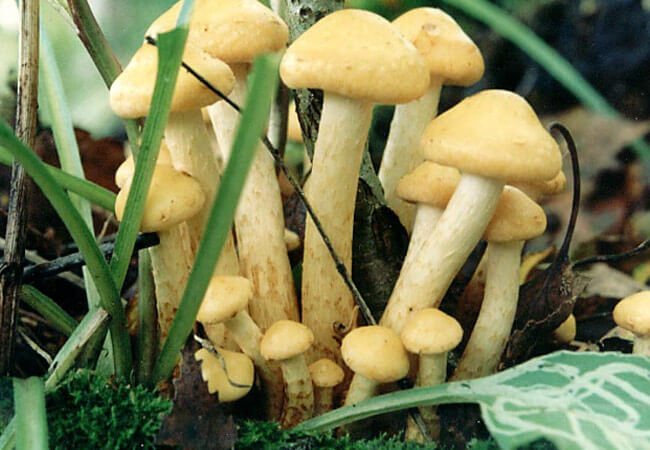
Walking through the autumn forest in search of a harvest, inexperienced adherents of a quiet hunt may well confuse these mushrooms with honey agarics. And the point is not even that the alder firewood is similar to the mushrooms externally, but it also grows on trees and stumps in whole colonies, and even the fruiting period for them coincides.
And this similarity is precisely where its danger lies, because such a find is completely unsuitable for food, therefore it is very important to be able to recognize this mushroom
Alder fire
Alder moth - lat. Pholiota alnicola
The moth is also called alder flake. This mushroom belongs to the stropharia family and the genus of flakes.
Mushroom cap
Young moths have dense spherical caps that are attached to short and completely inconspicuous legs. As they grow older, the caps of the moths are transformed into a cone-shaped shape. And by the peak of ripening, the caps become completely flat-convex with a curved edge, similar to saucers and can reach a diameter of up to 6 cm.At young age, these mushrooms have a bright yellow-ocher, lemon color, which becomes even more intense during the growth process.
On the outside, the fireball cap is covered with the smallest scales that match the color of the main color of the mushroom, which makes them completely invisible. Only on closer inspection can you see these layers. Moreover, despite the humidity, the fire hat always remains slimy and sticky.
But along the edge there are thin flakes - the remains of a filmy bedspread, visible to the naked eye. They are usually white or brownish in color.
On the inside, the cap of the scale has often planted thin plates - hymenophores. Their color is yellow, however, by the time the spore sacs mature, the plates darken and acquire a rusty or brown hue.
Stipe
The stem of the moth is curved, elongated and rather thin - from 3 to 10 cm in length and 0.5 cm in diameter. Old mushrooms have a hollow stem. It has a fibrous texture and a white coating, but not uniform. Above the ring that disappears over time, the surface of the leg is smoother and lighter. And below the ring is pretty fibrous and dark - brown.

Alder moth - lat. Pholiota alnicola
Place of growth
When the temperature difference becomes more obvious closer to autumn, moths begin to appear in the forests. High humidity is the most optimal environment for them. Therefore, the culmination of their growth occurs just in the autumn rainy season. These mushrooms grow in large groups on dead wood of alder and willow. Less commonly, alder flakes can be found on oaks and beeches.
Alder firewood has a very extensive growing area and therefore it can be found both in Primorye and in the European regions of the Russian Federation, as well as in the south.
Usually parasitic moth colonies settle on fallen deciduous trees. However, fungi often spread along the ground near the tree "donor".
The edibility of the mushroom
Outwardly, alder flakes are very attractive. A bright yellow color, a neat shape, and a pleasant sweetish smell are often a sign of a good harvest for inexperienced mushroom pickers. However, this mushroom tastes very bitter and generally unsuitable for food.
Despite the low degree of toxicity, the use of scales can still lead to poisoning. The pickled or salted alder moth is considered especially dangerous, since vinegar and salt increase the concentration of poisons by 2-3 times.
Similar types and differences from them
It is not difficult to confuse alder fire with honey agarics. These mushrooms are not only very similar in appearance, but also the ripening and growth times are the same for them. However, there are a couple of criteria by which you can identify an unsuitable mushroom:
- Honey mushrooms grow near coniferous forests mainly on the "remains" of coniferous trees. But the moth feels at ease only in deciduous windbreaks.
- You can also distinguish a mushroom from a moth by the ring. Honey mushrooms have a more pronounced and dense ring on the legs.
Fire alder or alder flakes for indiscriminate mushroom pickers can cause poisoning. And in order to avoid this, you need to learn to distinguish a poisonous mushroom from edible and tasty mushrooms.
Poisoning symptoms, first aid
Cases of poisoning with alder flake are extremely rare, the fruit body should not be consumed in any form. With intoxication, the symptoms appear after 2 hours and gradually increase:
- mild nausea;
- then the headache begins;
- continuous vomiting joins the symptoms;
- there is pain and pain in the stomach, sweating;
- supplements the signs of diarrhea poisoning.
An increase in body temperature is possible. If you do not take action in a timely manner, the body is threatened with dehydration and complications in the kidneys, heart or liver. It is impossible to remove toxins from the body at home; you need to contact the nearest medical institution or call an ambulance. Before providing qualified assistance, you can alleviate the symptoms:
- Make a weak solution of manganese and wash the stomach.
- Sorbents are accepted: white or activated carbon, "Polysorb".
- You cannot stop diarrhea if the symptom has not yet manifested itself, they drink laxatives or wash the intestines with an enema with manganese.
- For chills, take a hot bath or wrap themselves in a blanket.
The composition of the detox preparation Fire from parasites
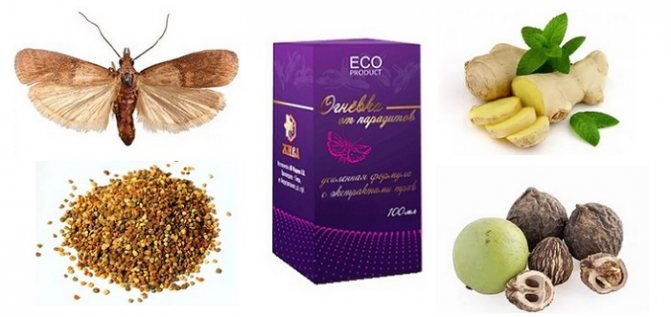
A safe detox agent Ognevka is made from natural raw materials. The composition included:
- bee moth - destroys parasites, has an antibacterial effect, stimulates the growth of immunity;
- propolis - fights against fungi, bacteria, parasites. Eliminates the phenomena of intoxication, cleanses the blood;
- fir juice - has antiviral, antibacterial effect;
- ginger - has a detrimental effect on the larvae. Stops infection;
- black walnut - cleans the blood and lymph from the waste products of parasites;
- cedar resin - has a choleretic effect, inhibits parasites;
- larch - fights intoxication, helps damaged cells recover;
- St. John's wort, dandelion, oak bark, echinacea, horsetail and 9 more plant extracts - enhance the effect of the main components, remove toxins, and have a health-improving effect on internal organs.
Beneficial features
The pulp of royal mushrooms is good for health, because, with its low calorie content, it contains the entire spectrum of essential amino acids, and in terms of the amount of phosphorus and calcium, it is comparable even to fish fillets.
Due to the presence of iron and magnesium in the pulp, these mushrooms are involved in the processes of hematopoiesis, normalize the conduction of impulses along nerve fibers, affect the synthesis of proteins in the human body and are catalysts for various chemical reactions.
In golden, gummy and edible foliots, substances were found that exhibit bactericidal and antifungal effects. The mucus covering the surface of the fruit bodies of golden and edible scales has the following properties:
- stimulate cerebral circulation;
- improve immunity;
- relieve fatigue;
- restore vitality.
Flakes contain squarrozidine, a unique compound that inhibits the xanthine oxidase enzyme. The enzyme xanthine oxidase promotes the crystallization of uric acid in joints, kidneys and body tissues. By inhibiting this enzyme, squarrozidine prevents the loss of urate salts and thus prevents pain attacks in people with gout. In clinical practice, drugs containing a xanthine oxidase inhibitor as an active ingredient are used to treat gout.
There is evidence that the funds made on the basis of these mushrooms are capable of exhibiting anti-cancer properties.



